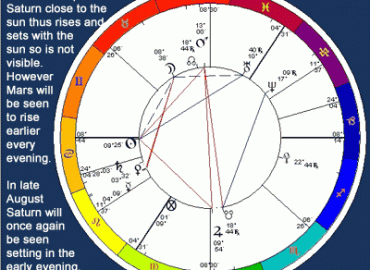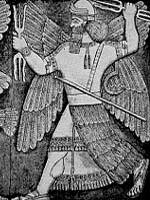Bernadette Brady
May 2006
One of the traditional teachings within Medieval and also Traditional astrology is that a planet is weakened when it is too close to the Sun. Such a concept is called either Combust (when the planet is within 8 or so degrees of the Sun) or Under the Sun’s Beams (within 15or so degrees of the Sun). Now a planet’s relationship to the Sun was also of great importance to the Babylonians and indeed this rather “odd” technique in horoscopic astrology may well have its roots in their visual methods of watching for the appearances and disappearances of the planets. We have many letters to the Assyrian kings from the astrologer-priest devoted to this observation, such as:
If Jupiter [becomes visible] in Tammuz
(IV): [the land will dwell] in quiet.[1]
This refers to the first appearance of Jupiter from under the Sun’s beams in the month of Tammuz. Another such letter reads:
If Venus disappears in the east in Nisan
(I) from the 1st to the 30th day: there will be
wailings. [2]
This notes that the planet Venus has disappeared (under the rising Sun’s rays) in the month of Nisan and that this is a difficult omen.
The Rhythm of Sun and Planets
The planets [Venus, Mercury, Mars, Jupiter and Saturn] are visible in the night sky for most of the year but each planet will go through a period when it disappears from view. Such behaviour as noted above was closely watched by the Babylonian priest. However, as astrologers moved away from the sky and focused on the horoscope alone, this observance of disappearance and reappearance seems to have morphed into the doctrines of “combust” or “under the beams”. A planet is considered to be weakened or damaged by its close proximity to the sun but the ill-defined damaged may be better understood if one understands that the planet is no longer visible, is travelling through the underworld, like Nergal (Mars) as discussed in the April newsletter. However, Medieval and Traditional astrology simply judged these conditions by the number of degrees between the planet and the Sun in a horoscope.
But this is an over simplification which I believe distorts the actual key concept being examined. The visibility of a planet (ignoring the local weather) depends on three factors: firstly, the distance between the Sun and the planet; secondly, the latitude of the observer; and, thirdly, the time of the year when the planet disappears. By ignoring the sky and just looking at the two dimensional horoscope, horoscopic astrology has become blind to the latter two vital conditions.
Let us consider the chart for Ada Byron, Lady Lovelace (1815 – 1852). She was the daughter of the English poet Lord Byron but she found her poetry in mathematics and not only is accredited with conceiving the idea of the first computers but she is considered to have written the first software program. She was born 10 December, 1815, at 1.00 pm in London, UK.
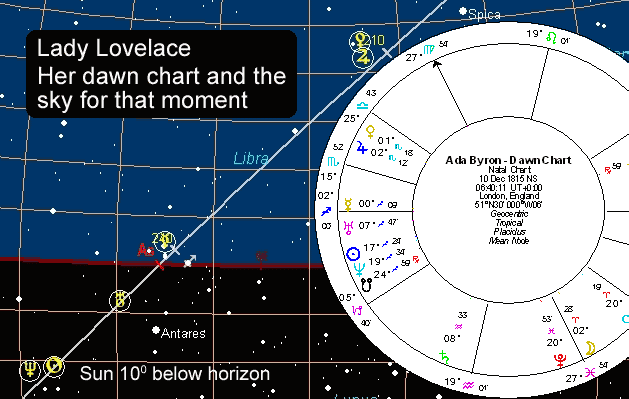
One of the features of her chart is her Venus-Jupiter conjunction and indeed if look at the chart for dawn on the day she was born (shown as insert), you will see that the Sun in the 1st house is 150 ecliptical degrees below the Ascendant and that the Venus-Jupiter conjunction in the 11th house is 300 ecliptical degrees above the Ascendant. In her chart therefore this Venus-Jupiter combination is quite strong and emphasised because it is so bright in the sky just before dawn – Ptolemy would point this out as being part of her strong solar doryphory, a particularly important medieval astrological technique but one that seems to be lost in later version of astrology.
Now the sky map above (and the chart) are set for dawn on that day. Daylight will begin to fill the sky for any location whenever the Sun moves to within 120 below the horizon. Importantly this is not 120 on the ecliptic but rather 120 in altitude (in this case depression), degrees measured above or below the actual line of the horizon. This is considered nautical twilight. If you look at the sky map above, the grid lines on the map are set for every 50, thus you can see the Sun is 100 below the horizon and the Venus-Jupiter conjunction is about 230 above the horizon. Thus this map is set for the time period where there was the half light of dawn on that December morning, but we can also see that the brilliant Venus-Jupiter conjunction would still be clearly visible but beginning to be lost in the Sun’s light.
By contrast, if we keep the same location (London) but move the time of the year to the month of May, we see a very different situation.
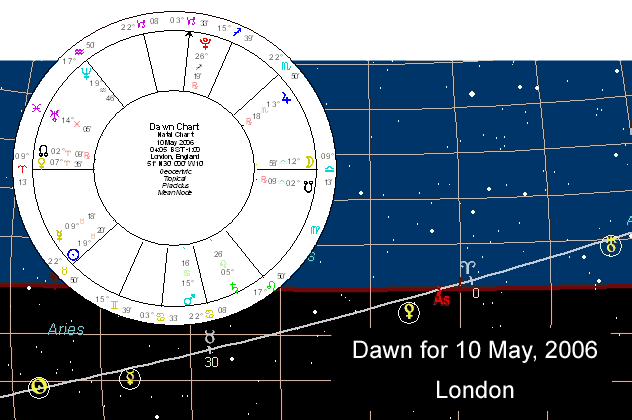
In the sky map (above) set for 10 May, 2006, in London, we can see that on this day Venus (similar to Lady Lovelace) is 420 ecliptical degrees ahead of the sun and rising before the Sun. But is this Venus visible? The sky map is set for the Sun being 100 below the line of the horizon (two grid lines down from the line of the horizon, just as in the case of the Lady Lovelace map), so once again this map is set for dawn. However, if you look at the chart for that moment (insert), you will notice that the Sun is at 190 Taurus and the Ascendant at 90 Aries. The Sun is 390 below the horizon, yet it is still the beginning of dawn.
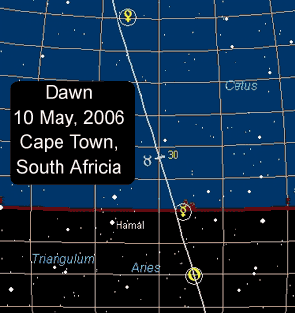
Furthermore the planet Venus, although well separated from the Sun, will not be seen to rise before dawn. Indeed at the time of dawn, Venus in the sky map is still below the horizon. This huge difference is caused by the angle that the ecliptic (the white line) forms to the horizon at the latitude of London. In this chart therefore Venus is really still “Under the Sun’s Beams”, even through Venus is 420 away from the Sun!
If we moved the location of this same chart to the southern hemisphere, let us say Cape Town, South Africa (latitude of 33/55 South), then the angle of the ecliptic and the horizon is hugely different. Venus is now clearly visible well before dawn, being about 300 of elevation above the horizon at the time (see sky map right).
Latitude and the time of the year makes a huge difference to the visibility of a planet.
So in returning to the astrological concepts of Combust and Under the Beams, if they are fragments of visual astrology (and indeed their very terms implies a visual element), then the application of orbs on the ecliptic which ignore the seasons and the latitude and thus the actual visual appearance, may be a gross over- simplification of a beautiful and meaningful visual technique.
Furthermore, in today’s astrological world of computer software, it is so easy to reconstruct the actual sky for any given horoscope and with such tools it may well be time for a re-evaluation of the implications of having a planet in a natal chart combust. It could prove most illuminating when one actually examines charts of whether the planet is actually consumed by the rays of the sun, rather than judging this condition in a chart based on an average situation for the seasons and latitude of Egypt – Ptolemy’s location.
In Your Own Chart
Have a look at the planets that rise before your sun on the day of your birth. If you own Starlight, have a look at your own natal sky map. Turn on the azimuth grid (the little “A” button in the sky map tool bar which will default to 15 degree slots), then animate the chart to move the Sun so that it is sitting 10 degrees below the horizon. Now look to see what planets are rising. If you do have planet’s rising above the horizon line, those planets will be most important in your life and even give you a clue as to your profession and preferred lifestyle. If you do not own Starlight, then see if you can use any other planetarium software, just so you can get a look at the sky for the dawn of the day of your birth. I think you will find it most illuminating!
[1] Hunger, Herman. (1992). Astrological Reports to Assyrian Kings. Helsinki, Finland: Helsinki University Press. pg.50.
[2] id bid pg 254.



